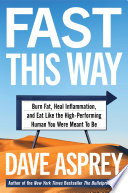

In 'Fast This Way', the author dives deep into the scientific principles behind fasting, explaining how it can be a powerful tool for physical and mental health. Fasting isn't just about abstaining from food; it's about understanding how the body processes energy and how it can adapt to periods of deprivation. The author discusses the physiological changes that occur during fasting, including improved insulin sensitivity, enhanced fat metabolism, and cellular repair processes such as autophagy. This section emphasizes that fasting can lead to increased longevity and better overall health if practiced correctly. The science is backed by numerous studies and real-life examples, illustrating how fasting can enhance cognitive function, boost energy levels, and promote a sense of well-being. The author also addresses common misconceptions about fasting, debunking myths that it leads to muscle loss or extreme hunger. Instead, the narrative encourages readers to view fasting as a strategic method of nourishing the body and mind.
Continue readingOne of the key benefits of fasting highlighted in the book is its impact on mental clarity and cognitive function. The author explains how fasting can lead to heightened focus and improved productivity. During fasting, the body produces ketones, which are a more efficient fuel source for the brain than glucose. This shift in energy source can lead to improved mental clarity, creativity, and problem-solving skills. The author shares personal anecdotes and testimonials from others who have experienced significant improvements in their mental acuity while fasting. This section also explores the concept of mental resilience, suggesting that the discipline required for fasting can translate into other areas of life, enhancing overall performance and decision-making abilities.
Continue readingThe book positions fasting not just as a dietary strategy but as a profound tool for personal growth and self-discovery. The author encourages readers to embrace fasting as a way to challenge their limits and confront their relationship with food and consumption. By voluntarily abstaining from food, individuals can gain insights into their habits, cravings, and emotional triggers. This journey of self-exploration can lead to greater self-awareness and empowerment. The author provides practical tips on how to start fasting, including setting intentions and gradually increasing fasting periods. Through these practices, readers can cultivate a deeper understanding of their bodies and minds, ultimately leading to transformative changes in their lives.
Continue readingThe author distinguishes between intermittent fasting (IF) and extended fasting, explaining the benefits and challenges of each approach. Intermittent fasting typically involves cycles of eating and fasting within a 24-hour period, while extended fasting can last for several days. Each method has its own set of advantages, and the author provides guidance on how to choose the right approach based on individual goals and lifestyles. The book discusses the physiological effects of both types of fasting, including their impact on metabolism, hormone levels, and overall health. Additionally, the author shares practical advice on how to safely implement these fasting strategies, emphasizing the importance of listening to one's body and seeking professional guidance when necessary.
Continue readingThe role of community in the fasting experience is another significant theme in the book. The author highlights the importance of social support and shared experiences in enhancing the fasting journey. Fasting can often be a solitary endeavor, but connecting with others who are also practicing fasting can provide motivation, accountability, and encouragement. The author shares stories of fasting groups and communities that have formed, illustrating how collective experiences can amplify the benefits of fasting. This section encourages readers to seek out or create their own fasting communities, whether online or in person, to foster a sense of belonging and shared purpose.
Continue readingFasting has long been associated with spiritual practices, and the author explores this connection in depth. The book discusses how fasting can serve as a form of meditation and reflection, allowing individuals to connect with their inner selves and explore their spiritual beliefs. The author shares insights on how fasting can lead to heightened awareness, gratitude, and a deeper understanding of one's purpose in life. This section encourages readers to approach fasting with a holistic mindset, integrating physical, mental, and spiritual aspects into their practice. By doing so, individuals can unlock a more profound sense of fulfillment and meaning in their lives.
Continue readingThe final key idea revolves around practical tips and strategies for successfully implementing fasting into daily life. The author provides actionable advice on how to prepare for fasting, what to expect during the process, and how to break a fast safely. This section includes meal planning, hydration strategies, and recommendations for maintaining energy levels while fasting. The author emphasizes the importance of tailoring fasting practices to individual needs and preferences, encouraging readers to experiment and find what works best for them. By equipping readers with these practical tools, the author aims to empower them to embark on their fasting journey with confidence and intention.
Continue reading